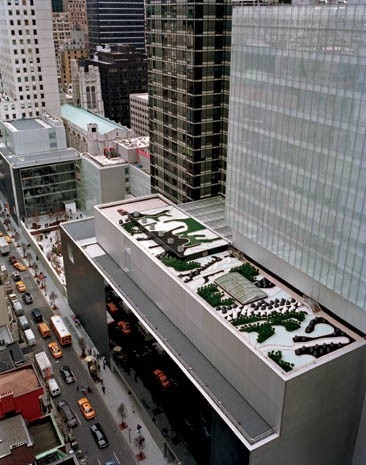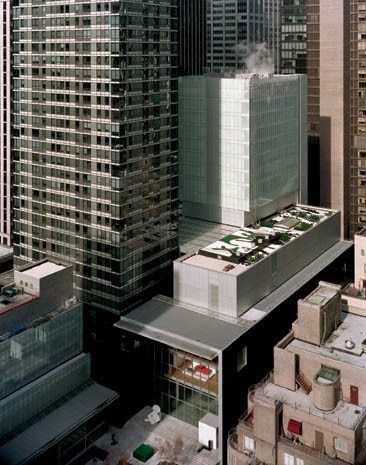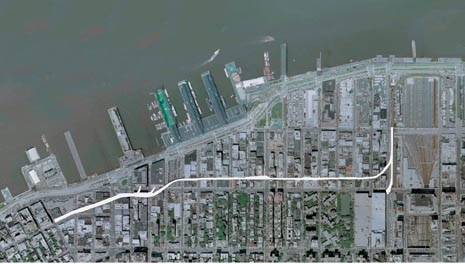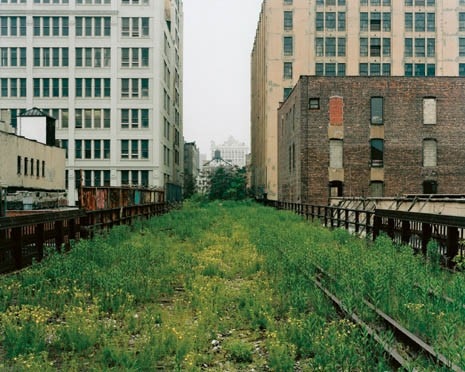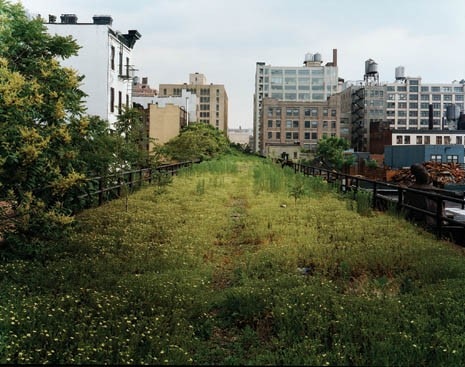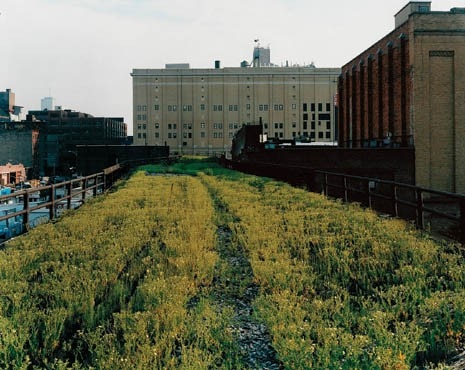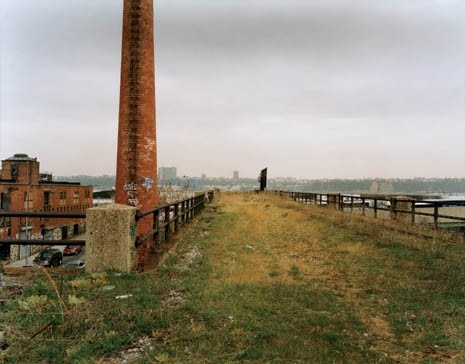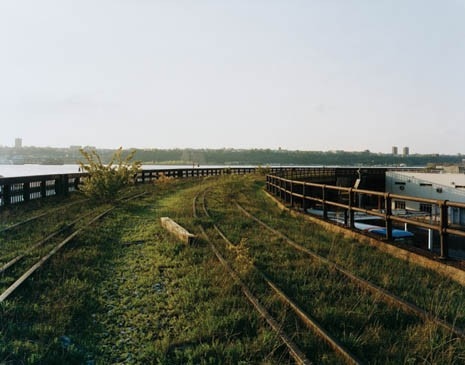Look but don't touch
Tim Richardson
Landscape architecture suddenly has a strong presence in New York. It is key to the beleaguered and over-politicised attempts to create a suitable memorial and commercial resurrection at the Ground Zero site, and it is also the medium for what may come to be considered the "real" 9/11 memorial for the city: the Fresh Kills landfill site, the island where all the debris (and therefore all the human remains) from Ground Zero was taken. Perhaps the more diffuse, reflective and ambiguous qualities of landscape - as opposed to the object-based certainties of architecture - suit the city's mood at the moment. Ken Smith is one of a new generation of landscape architects and garden designers - led by Martha Schwartz in Boston, with whom Smith worked for several years - who have abandoned the certainties of European naturalism and the pieties of American corporate modernism to produce work that is characterised by exuberant use of colour, artificial materials, surreal scaling, humour, repetitive pattern and witty comments on history and culture. This is design defined by ideas rather than plants or the architectural use of hard materials. In general terms, the idea is that a single concept or visual motif should inform every aspect of the space. Smith's idea for the twin roof spaces at MoMA was based on the concept of camouflage as an intersection between urban style and natural landscape, and also as a comment on the inescapably artificial qualities of all manmade landscape design, which is a preoccupation for landscape conceptualists. There is no access to the garden spaces: they must be looked down on from above at a steep angle, and in that sense they function as parterres in the Baroque sense (the design satirises the tradition of 17th-century gardens such as Het Loo in the Netherlands). As Smith explains, "This garden is a simulation of a simulation of nature." One disappointment at MoMA is that the new gardens can only be seen by those working in buildings that overlook the site and not by museum visitors. Nonetheless, distant views can be obtained from the rooftop bar of the Peninsula Hotel on 5th Avenue at 55th Street (take binoculars). The amorphous ground plan is made up of quantities of ultramarine crushed glass, white crushed marble, black recycled plastic, green plastic boxwood topiaries and white and black hollow plastic cones. Flesh-coloured dividers made of styrofoam allow these artificial gardens to clamber round numerous immovable vents and skylights. Having no irrigation or maintenance budget, these had to be gardens made entirely of lightweight, cheap, non-living materials. The result is amusing, original and absorbing to look at and was made on a surprisingly large scale. The temporary (or "slow-temporary") nature of the materials, which will probably last less than 10 years, is one of the controversial aspects of such conceptualism. The designers argue that if a space is successful, there is usually no reason why it should not simply be renewed. Smith has also departed somewhat from conceptualist methodology by insisting that there is no specific meaning behind the work and that there is no intended or expected emotional response generated by it. Questions on such subjects elicit merely a shrug of the shoulders and a benignly quizzical expression from Smith. The "concept" emerges here as simply a decorative peg. Is this the open interpretation pursued to the point of vacuity? Or is this a valid stance from a designer who is playing a game, teasing the establishment as part of an attempt to escape from a landscape milieu which still carries with it the burden of naturalism and all of its expectations? Whatever one's opinion, it is certainly unusual to find an architect or landscape architect who professes no humanistic mission and no didactic purpose whatsoever. Superficially, the High Line project appears to be the antithesis of the MoMA roof terraces: a plan for a naturalistic, ecologically friendly, inclusive public space. In a city that is poorly served in terms of green space (a single massive park in the centre of the island, much-loved but perhaps over-praised, does not represent good city planning), landscape has suddenly climbed towards the top of the aesthetic agenda. That the debate surrounding the issue has so far been couched in essentially sentimental terms is testament to a general innocence about landscape in Manhattan. The notion that ecology does not necessarily equate with authenticity in a landscape setting has so far not been raised. Following an open design competition which attracted 720 entrants, a partnership between New York architectural firms Field Operations (which has also secured the Fresh Kills project) and Diller Scofidio + Renfro was appointed. The mantra of their proposal is "keep it simple, wild, quiet and slow", epithets rarely applied to Manhattan. It is hoped that work will start by the end of the year, with the project being completed by 2010. Field Operations, which undertook an ecological survey of the High Line site, came to the conclusion that the "otherworldly" atmosphere and ecological character of the overgrown rail track was worth keeping. So this is not going to be a narrative experience of discrete episodes, but rather multiple variations on ecological themes, with areas such as a "vegetal balcony", shade garden, sumac woodland, river overlook, butterfly garden, grassland preserve, sundeck and a large outdoor event space. There will be 12 different entrances, each with its own character, while pedestrians at street-level looking up, or office workers looking down, will encounter a tree canopy floating 50 ft above ground level. There is not a great deal that is innovative about the winning High Line proposal. The structural aspects to the scheme are conventionally modernist, and ever since Le Corbusier the received wisdom has been that the best landscape complement to such work is naturalistic or even untouched landscape, i.e. a woodland setting, an orchard, a park up to the house in the English tradition, or else swaying grasses and perennial flowers offsetting the crisp lines of the architecture. The problem with this approach in the linear context of the High Line is that there is no architectural focus, while a narrative or episodic quality to the scheme has been ruled out. The idea is that the various eco-spaces will flow into each other seamlessly. The architects put it like this: "A unified but flexible design permits shifts and gradations of environment and experience without segmentation." While this is easy to say, it is difficult to achieve in practice. It assumes, for example, that the different ecological zones will segue together seamlessly just because they are, well, ecological. The naturalistic fallacy that a "soft" landscape is somehow less artificial than other manmade solutions has nevertheless emerged as a good way of winning design competitions. In the case of the High Line it was quite a coup: what Field Operations and Diller Scofidio + Renfro have sold to the jury is a glorified wasteland. It is an open secret in landscape circles that "eco" sells. Any proposal which is tricked out with feel-good references to natural habitat, birdlife, sustainable irrigation systems, tree planting, havens for butterflies and the like can be sure of a sympathetic hearing, especially if a jury is low on landscape expertise - as it was in this case, notwithstanding the presence of Bernard Tschumi. Politicians, business representatives and local residents often feel that they can more easily understand and evaluate the ecological rather the aesthetic components of a proposal. Thus we have seen over the past decade an increasing number of landscape firms making ecological awareness and sustainability a key aspect of their work - to the disgust of conceptualists such as Martha Schwartz, who has been outspoken in her attacks on eco-sensibility for profit. This is not to suggest that James Corner's Field Operations has cynically adopted an ecological pose. Nonetheless, their success with the High Line proposal is symptomatic of a wider trend. Tim Richardson is a London-based independent landscape critic and historian. His latest book is English Gardens in the 20th Century (Aurum Press, 2005).
High Line
The High Line was originally built between 1929 and 1934 as an elevated railway - 10-20m wide and 6-10m high - serving the warehouses and businesses along the lower West Side. As road freight took over in the 1960s, sections began to be torn down, and trains finally stopped running in 1980. In 1991 the southernmost section, spanning five blocks, was demolished to make way for new buildings. A decade later, outgoing Mayor Rudolph Giuliani signed papers committing the city to the demolition of the entire High Line, but by this time local lobbyists were organised and the decision was successfully challenged in court. By 2003 the situation had been effectively reversed, with the city council pledging an initial $15.75 million to a project to resurrect the overgrown track as a seven-acre park-promenade for New Yorkers (estimated cost: $65-$100 million)
Diller Scofidio + Renfro & Field Operations High Line
Designed as a continuous, single-surface ribbon that weaves in and out of the new park's "natural preserves", the design by Diller Scofidio + Renfro in collaboration with Field Operations is based on a system of individual pre-cast units that interface the High Line's thick structural section. Thanks to a modular plank system the proportion of pedestrian space to plant space can be altered at will over the length of the park, allowing "diverse natural habitats" to be engineered. This strategy is referred to by the architects as "agri-tecture"
